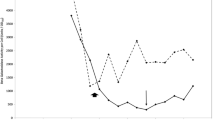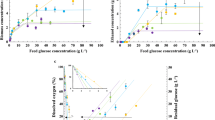Summary
The ability of Klebsiella pneumoniae to grow on its own soluble lysis products is shown in a series of batch growth experiments. Maximum specific growth rate coefficients ranging from 0.69 to 1.46 h-1 were obtained with experimental “cryptic” yield coefficients ranging between 0.42 to 0.52 (mg-cell-C/mg-substrate-C). These kinetic data are used to calibrate a model which demonstrates that depression of theoretical maximum yield coefficients relative to experimentally obtained values can be explained by “cryptic” growth phenomena without the need to resort to the use of physiologically undefined, mathematical constants. Growth of K. pneumoniae on sonicated cells derived from steady-state chemostat cultures was followed in batch culture and observed to occur with no lag phase. Batch growth curves did not indicate either diauxic or polyauxic growth, suggesting simultaneous utilization of the complex organic substrate mixture. These data suggest that “cryptic” growth is probably a real event occurring in growing chemostat cultures under ideal growth conditions and most probably also under starvation conditions.
Similar content being viewed by others
References
Drozd JW, Linton JD, Downs J, Stephenson RJ (1978) An in situ assessment of the specific lysis rate in continuous cultures of Methylococcus sp. (NCIB 11 083) grown on methane. FEMS Microbiol Letters 4:311–314
Egli Th, Lindley ND, Quayle JR (1983) Regulation of enzyme synthesis and variation of residual methanol concentration during carbon-limited growth of Kloeckera sp. 2201 on mixtures of methanol and glucose. J Gen Microbiol 129:1269–1281
Evans CGT, Herbert D, Tempest DW (1974) The continuous cultivation of micro-organisms. 2: construction of a chemostat. In: Norris JR, Ribbons DW (eds) Methods in Microbiology, vol 2, Academic Press, London, pp 277–327
Gaudy AF, Yang PY, Obayashi AW (1971) Studies on the total oxidation of activated sludge with and without hydrolytic pretreatment J Water Poll Contr Fed 43:40–54
Hamer G (1985) Lysis and “cryptic” growth in wastewater and sludge treatment processes. Acta Biotechnol 2:117–127
Hamer G, Egli Th, Mechsner KI (1985) Biological treatment of industrial wastewater: a microbiological basis for process performance. J Appl Bacteriol Symp Supp 127S–140S
Hamer G, Bryers JD (1985) Aerobic thermophilic sludge treatment — some biotechnological concepts. Conserv Recycl 8:267–284
Koch AL (1959) Death of bacteria in growing culture. J Bacteriol 77:623–627
Linton JD, Stephenson RJ (1978) A preliminary study on growth yields in relation to the carbon and energy content of various organic growth substrates. FEMS Microbiol Lett 3:95–98
Martin EJ, Washington DR (1964) Kinetics of the steady-state bacterial culture. 1. Mathematical model. Proc Purdue Industrial Waste Conference, Lafayette, Indiana, part 2, 724–737
Mason CA, Hamer G, Bryers JD (1986)a The death and lysis of microorganisms in environmental processes. FEMS Microbiol Rev 39:373–401
Mason CA, Bryers JD, Hamer G (1986)b Activity, death and lysis during microbial growth in a chemostat. Chem Engng Commun 45:163–176
Nioh I, Furusaka C (1968) Growth of bacteria in the heat-killed suspensions of the same bacteria. J Gen Appl Microbiol 14:373–385
Obayashi AW, Gaudy AF (1973) Aerobic digestion of extracellular microbial polysaccharides. J Water Poll Contr Fed 45:1584–1594
Pirt SJ (1965) The maintenance energy of bacteria in growing cultures. Proc R Soc Lond [Biol] 163:224–231
Postgate JR, Hunter JR (1963) The survival of starved bacteria. J Gen Microbiol 29:233–263
Postgate JR, Hunter JR (1963) The survival of starved bacteria. J Appl Bact 26:295–306
Postgate JR (1976) Death in macrobes and microbes. In: Gray TRG, Postgate JR (eds) The survival of vegetative microbes. Proc Symp Soc Gen Microbiol vol 26, Cambridge University Press, Cambridge, pp 1–18
Roels JA (1980) Simple model for the energetics of growth on substrates with different degrees of reduction. Biotechnol Bioeng 22:33–53
Ryan FJ (1959) Bacterial mutation in a stationary phase and the question of cell turnover. J Gen Microbiol 21:530–549
Schlegel HG (1981) Allgemeine Mikrobiologie (5th edn) Georg Thieme Verlag, Stuttgart
Stouthamer AH (1979) The search for correlation between theoretical and experimental growth yield. Int Rev Biochem 21:1–45
Tempest DW, Neijssel OM (1984) The status of Y ATP and maintenance energy as biologically interpretable phenomena. Ann Rev Microbiol 38:459–486
Author information
Authors and Affiliations
Rights and permissions
About this article
Cite this article
Mason, C.A., Hamer, G. Cryptic growth in Klebsiella pneumoniae . Appl Microbiol Biotechnol 25, 577–584 (1987). https://doi.org/10.1007/BF00252019
Received:
Revised:
Issue Date:
DOI: https://doi.org/10.1007/BF00252019




